Scroll through the lesson and click on notation/video/audio links to load the interactive players.
Please subscribe to get full access to all lessons for only $7.95/month PLUS 1 week free trial.

Riff Interactive lessons are
LESS expensive and
MORE interactive than alternatives!
More Info
|
|
| Lesson Subject:
Blues Legends I |
| What you learn:
Muddy Waters Style - Part 1 |
| Teacher: Michael Johnson |
Michael:
Muddy Waters basically launched the Chicago electric blues guitar scene. Muddy
would play at juke joints that were located near loud factories. Muddy's
solution was to amplify his guitar to be heard. Little did he know this
would be the beginning of a new revolution in guitar technology. Muddy's influences were
basically the old delta blues players like Robert Johnson, Blind Melon
Johnson,... In this lesson you are going to cover some of these classic
progressions and licks. Here's a sample of the licks you will learn:
Lesson Sample
Michael: Here's our jam track, which is in the key of E.
Michael: The licks will basically be in the E
Minor Blues scale. Here's the pattern.
Michael: Most of the licks will follow the chord changes.
Here's our first Muddy lick:
Lick 1
Michael: Notice how the lick pattern repeats and shifts over the chord changes, this is a common technique Muddy uses for his rhythm style.
You play over the I, IV, V of the progression. Here's the tab breakdown of the progression:
Michael: You can basically use the barre chord formation to play these licks.
Here's a few picture examples.
Step 1 - E Major Chord
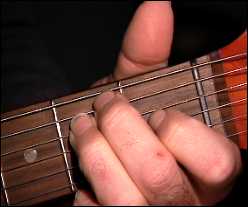
Step 2 - Barre 2nd Fret
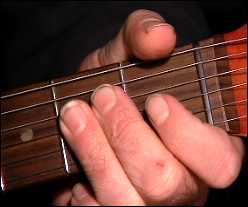
Step 3 - Hammer 3rd string/1st
fret
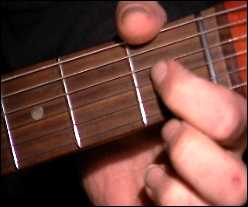
Michael: See how it works over the E major chord?
EC:
standard blues progression with trills
Michael: Yes EC!
Step 1 - A Major Barre Chord (5th
fret)
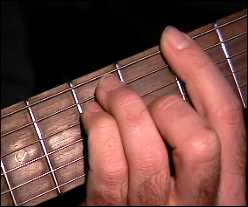
Step 2 - Barre 3rd & 4th fingers
on A Barre Chord
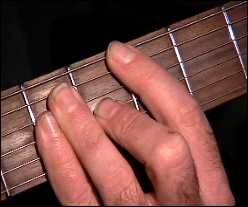
Step 3 - Hammer 3rd String in A
Barre Chord Position
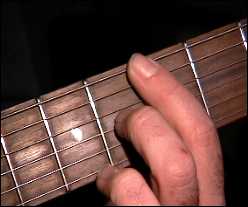
Michael: OK you get the idea on using the
chord formations, here's a blues turnaround.
Lick 2 - Turnaround
Michael: Most blues progression end with a "turnaround," Muddy used this lick often,
you pick the low E with your thumb and 4th string with your 2nd finger on the picking hand.
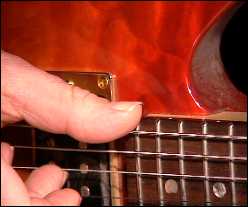
Michael: It's a cool sounding technique, let's go to the next lick.
Lick 3
Michael: In this lick you can start on the octave (12th fret) of the E and fall back into the other patterns of the progression,
it's basically playing off the barre chord pattern, but with a subtle twist.
EC: Nice walking baseline,
a good tool to have!
Michael: This lick uses a chromatic run that bounces between the octave E on the 5th string/7th fret.
The real fun is when you play it over the jam track
Turnaround Step
1 -
Open 6th String - Hold 4th Finger on 7th Fret/5th String
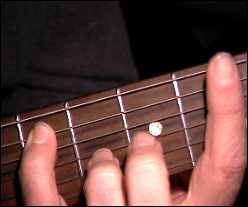
Turnaround Step
2 -
4th fret/ 6th String - Hold 4th Finger on 7th Fret/5th String

Turnaround Step
3 -
5th fret/ 6th String - Hold 4th Finger on 7th Fret/5th String
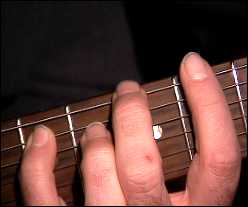
Turnaround Step
4 -
6th fret/ 6th String - Hold 4th Finger on 7th Fret/5th String

Turnaround Step 5 -
7th fret/ 6th String - Hold 4th Finger on 7th Fret/5th String
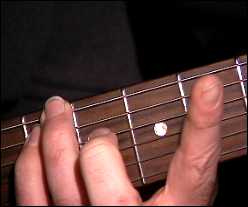
gman:
I love that turnaround, it's pretty common
Michael: Oh yeah, it's a classic notice how the licks shift.
LV8RDOC:
I love new variations on an old theme,
the octaves really work!
Teacher: Here's lick 4:
Lick 4
Michael: That's the beauty of these licks, the possible combinations you can use over the progression.
Here's Lick 5:
Lick 5
Michael: Notice how you play around the open chord structure instead of the barre chords,
you combine the E minor blues scale pattern and then build licks around the chords.
muddy:
Keb Mo, uses that technique all the time
Michael: You bet, and guess where this all comes from, the Delta Blues!
EC:
the old blues scale
Michael: You bet!
gman:
I love the twist you did on the turnaround
muddy:
yes, you hung longer on the intervals
LV8RDOC:
I always get caught up in the same old e blues this will give me lots of alternatives
Michael: Well, time for me to go, we'll cover more blues next time!
|
<< load notation from left
|
|
<< load audio from left
|
<< load audio from left
|